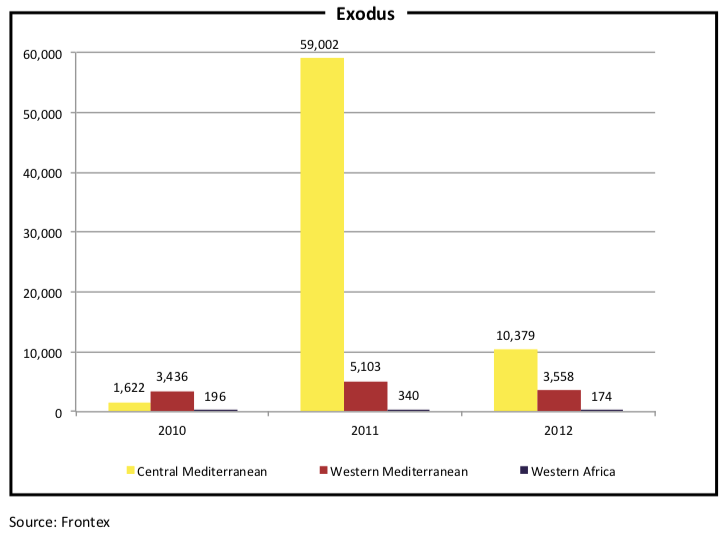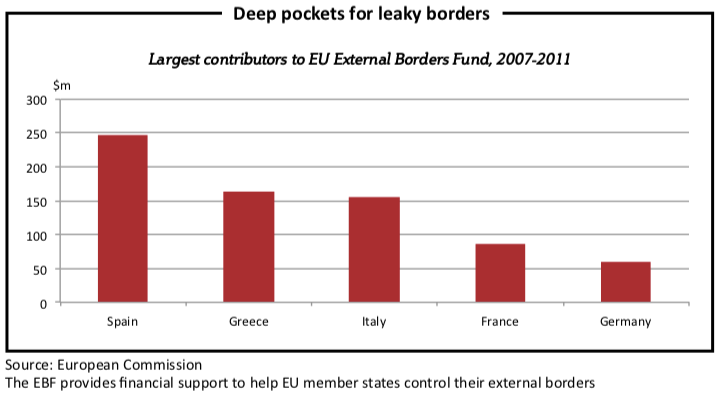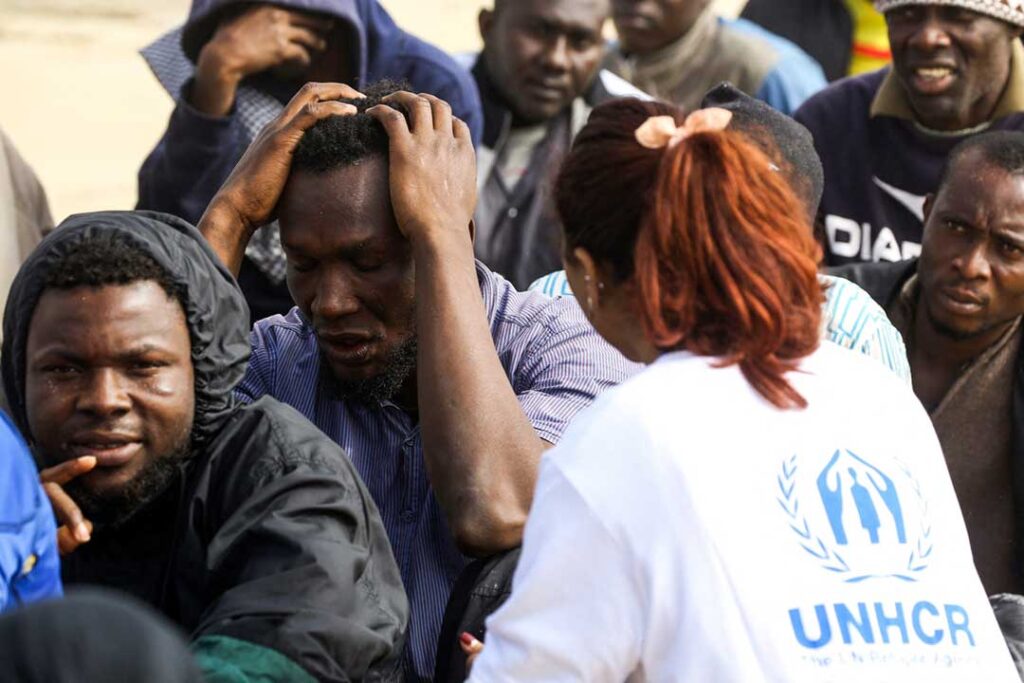Africa: no continent for young people
Thousands of Africans drown every year as they sail to Europe in search of jobs
Foday Sano is homesick. In December last year, the former taxi driver’s assistant from Guinea-Bissau called his sister from his new home in Milan, Italy. Although Mr Sano, in his early 30s, had risked his life twice before finally landing in Europe in 2009 and receiving asylum in 2010, he told her he wanted to return.
Mr Sano made his first attempt in 2007, when he and two friends boarded a rickety fishing skiff on the Senegalese coast with 85 other aspirant emigrants. They set sail for the Spanish-controlled Canary Islands, 100km west of Morocco in the North Atlantic Ocean.
Eight days later, the Senegalese-crewed craft was still pitching on the high seas when a Spanish patrol boat approached. The passengers panicked and the boat turned over. The coastguard rescued Mr Sano, but 15 of his fellow seafarers, including one of his friends, drowned.
A spike in the number of such tragedies brought the deadly traffic in African migrants to the world’s attention late last year. On October 3rd more than 350 people, mostly from Eritrea and Somalia, drowned when their boat capsized off the southern Italian island of Lampedusa. A further 150 were rescued from the Mediterranean.
One week later another vessel, carrying an estimated 260 African migrants, sank near the same island. At least 34 died, according to Italian navy reports. Later in October 92 people, almost all women and children, died of thirst in the Sahara desert after their vehicle broke down in northern Niger on the way to Algeria. “This was a case of poor people…being trafficked to Algeria,” from where they would catch boats to Europe, Moussa Akfar, a security expert based in Niamey, Niger’s capital, told the UK’s Guardian newspaper on October 31st 2013.
Media coverage is largely confined to reports of these tragedies, but they are just the tip of the iceberg. Tens of thousands of young Africans risk their lives each year to reach Europe.
More than 45,000 migrants sailed from Africa across the Mediterranean to Italy and Malta in 2013, according to the International Organisation for Migration (IOM). This is the highest number since 2008, with the exception of 2011, the year of the Libyan crisis, according to the IOM. The most commonly identified nationalities were Eritreans and Syrians, followed by Somalis and Egyptians.
Reliable estimates of how many die in the attempt are difficult to come by. More than 20,000 people have drowned in the past 20 years, according to the IOM’s tally. These include 2,300 in 2011 and around 700 in 2013.
Frontex, the European Union’s border agency, identifies three main sea routes used by African migrants to get to Europe: the western African route to the Canary Islands; the western Mediterranean itinerary, chiefly from Morocco to Spain; and the central Mediterranean passage, from Libya and Egypt to Italy.
The central Mediterranean was the most popular route in 2012, the latest year for complete statistics, with 10,379 recorded illegal border crossings favoured by Somalis, Eritreans and Tunisians. Next was the western Mediterranean route, with 3,558 documented illegal arrivals; and third, the western African route, with only 174 illegal entrants, according to the border agency.

When Mr Sano made his first attempt in 2007, the western African route was far more popular than it is now, according to the Global Detention Project, a Swiss-based research initiative. However, increased EU border patrols, more forced repatriations and a rising death toll in the North Atlantic prompted a significant decline in the number of sub-Saharan Africans using this route.
Mr Sano was one of those migrants caught in the tighter web. He spent four- and-a-half months locked up in one of 11 Spanish-controlled detention camps set up on the Canary Islands before being sent home.
For the most part, north African smugglers control the routes, said Abubacarr Jabbi, who runs Operation No Back Way to Europe, an NGO in Banjul, Gambia’s capital. The smuggling network, however, is wide and includes people from across west, north and east Africa as well as the Middle East.
“These traffickers usually have an expert knowledge of the local geography,” he said. “They are very subtle, shifting their departure points from one coastal settlement to another along the entire west coast of Africa.”
Small fishing skiffs usually ferry the migrants to bigger vessels anchored further out to sea, and the larger vessels complete the dangerous journeys, he said.
The cost of passage aboard a boat sailing from north Africa to Europe can range from $1,000 to $5,000, according to a 2013 report from the United Nations High Commissioner for Refugees. Some families opt to send their children alone or with relatives or friends because of these high costs, the report explained.
One reason migrants pay these amounts to make such risky journeys is that legal emigration to Europe is increasingly difficult. Immigration control took centre stage with the 1995 implementation of the European Union’s Schengen Agreement, which abolishes border controls between its members.
Europe has transformed itself into a “fortress”, with anti-immigration legislation a centrepiece of foreign and domestic policy, according to sociologists Claudia Finotelli and Giuseppe Sciortino, authors of a 2013 study published in the journal Perspectives on European Politics and Society. Stringent visa regimes, among other restrictions, simply disqualify many aspiring migrants, forcing them to take ever more desperate measures.
“Instead of solving a problem, criminalising migration has made matters worse,” Hein de Haas, co-director of the International Migration Institute at Oxford University, wrote last December. It increases refugees’ risks and “dependence on smuggling, and it decreases the chances of getting rescued if they find themselves in perilous situations, because people are afraid to get prosecuted for assisting illegal migrants”.
Several European countries have also attempted to “externalise” border control, Mr de Haas wrote in a 2006 report. “They usually do so by pressuring north African countries to clamp down on irregular migration and to sign readmission agreements in exchange for development aid, financial support for border controls, military equipment, and limited numbers of temporary work permits for immigrants,” he said. Spain, for instance, signed readmission agreements with Senegal and Mali in 2006.

Such measures, however, are bound to fail, because they do not address the underlying demographic and socioeconomic factors that push Africans to Europe.
Africa has the world’s fastest growing youth population, and 18 of the 20 countries with the highest percentage of population under 15 are African, according to the latest World Bank data. Only 40% of the 91m entrants into the African labour market find employment each year, according to the World Economic Forum. These are explosive statistics.

Mr Jabbi’s No Back Way to Europe NGO tries to discourage young Africans from travelling to Europe unlawfully on dangerous routes. “Back way” is street jargon for illegal migration, he explains.
Mr Jabbi, who made two unsuccessful emigration attempts, warns young Africans of the brutality they can expect at the hands of the human smugglers. “We were held in camps for months…and forced to call our relatives to ask them to send us [more] money or else we would be killed,” he said.
Yet despite such admonitions—not to mention the interceptions, repatriations and mass drowning—the numbers of Africans attempting these maritime crossings show no signs of diminishing, according to Frontex. If they make it, most are unlikely to find jobs in recession-wracked Europe because, like Mr Sano, they are uneducated and unskilled. Like him, many will long to return to Africa.
Poverty, youth unemployment, dangerous conflicts and insecurity across the continent remain powerful push factors. To stop the flow, African countries need to work individually and together to reverse the causes of emigration.
Until then, young Africans will continue to seek greener pastures in Europe, risking deportation and death. When life at home is unliveable, the promise of a better one across the sea can exert a fatal attraction.



